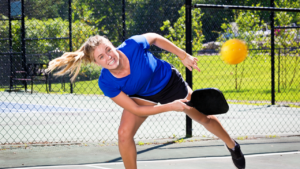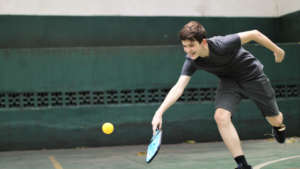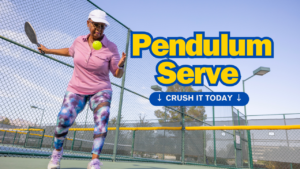
Defending against pickleball bangers is crucial for any player who wants to improve their game. I’ve seen many players struggle when facing powerful shots, often leading to quick points lost. Understanding the history of pickleball helps me appreciate its evolution and the rise of aggressive playstyles.
As the sport has grown, so have the techniques used by bangers. I’ve learned that staying calm and focused is key when dealing with fast-paced shots. In this post, I’ll share my top tips and strategies for effectively defending against these hard-hitting opponents. With practice and the right mindset, I believe anyone can enhance their skills on the court. Let’s dive into how to tackle those bangers head-on!
Table of Contents
Key Takeaways
- Stay alert during games to quickly react to bangers. Keeping your eyes on the ball will help you anticipate their shots.
- Position yourself correctly on the court to give yourself the best chance to return powerful hits. Being aware of your surroundings is crucial.
- Focus on hitting deep returns to push bangers back, making it harder for them to attack.
- Use a soft game approach when needed. Soft shots can disrupt a banger’s rhythm and force them to change their strategy.
- Always watch for outgoing balls, especially when a banger is about to hit. This helps you prepare for their next move.
- Practice defensive drills regularly to enhance your skills. Developing soft hands will improve your ability to handle fast shots effectively.
Understanding Pickleball Bangers

Banger Characteristics
A pickleball banger is a player known for hitting powerful shots. These players often use strong paddles to generate speed. They focus on aggressive play, aiming to dominate the game. Bangers usually hit the ball hard and fast, making it tough for opponents to respond.
I have faced many bangers in my pickleball journey. Their speed can be intimidating. Recognizing their style helps me adjust my strategy for defending against pickleball bangers.
Impact on Game Pace
Bangers significantly change the pace of a pickleball game. Their hard shots create quick rallies and force opponents to react quickly. This fast pace can lead to mistakes if players are not prepared. The intensity of these shots often shifts the game’s rhythm, making it challenging to maintain control.
Understanding this impact is crucial. I’ve noticed that when playing against bangers, I must stay focused and anticipate their next move. Slowing down my reactions helps me counter their power.
Adapting Playstyle
Adapting my playstyle is essential when facing bangers. I need to employ specific pickleball tips to handle their aggressive attacks effectively. One effective strategy is using the perfect pickleball lob. A well-placed lob can catch a banger off guard and create opportunities for me.
Positioning on the court also matters. Staying closer to the net allows me to intercept their shots more effectively. This tactic gives me a better chance to return the ball with precision.
Common Strategies
There are several strategies to consider when dealing with bangers:
Lob Shots: Use high lobs to push them back.
Dinking: Focus on soft shots near the net.
Placement: Aim for corners or unexpected areas.
These strategies help disrupt their rhythm and force them into uncomfortable positions.
Importance of Team Play
In team format pickleball, communication is key when facing a banger. My partner and I must coordinate our movements and cover each other’s weaknesses. This teamwork can make a significant difference in handling powerful shots.
Stay Prepared and Alert

Anticipate Shots
Focus during matches. It helps to anticipate banger shots. I often find that staying mentally engaged allows me to predict where the ball will go. This can make a big difference in my game. Keeping my eyes on the opponent’s paddle position gives me clues about their next move.
Being aware of your surroundings is essential. Notice the patterns in your partner’s play as well. This awareness can improve your overall performance. If both players are alert, they can support each other better during rallies.
Develop Quick Reflexes
Quick reflexes are crucial against fast-paced plays. Players must respond swiftly when defending against pickleball bangers. I practice drills that enhance my reaction time. For instance, I use a wall to hit the ball back and forth, which sharpens my reflexes.
Another effective method is practicing serves. Serving consistently helps build confidence when facing tough opponents. When I serve well, it puts pressure on them right from the start.
Practice Mental Readiness
Mental readiness is key during intense matches. Staying calm under pressure can change the game’s outcome. I remind myself to breathe deeply and focus on each point as it comes. This helps me avoid getting overwhelmed by aggressive opponents.
Visualization techniques also assist in mental preparation. Before matches, I imagine successful plays and positive outcomes. This practice boosts my confidence and keeps me relaxed during competition.
Communication with Partner
Effective communication with your partner can significantly help with defending against pickleball bangers. Discuss strategies before playing together. Agree on how to handle certain shots and cover each other’s weaknesses.
During the match, call out your intentions clearly. Saying “mine” or “yours” ensures both players know who will take the shot. This prevents confusion and missed opportunities.
Analyze Past Matches
Reviewing past matches provides valuable insights. Watching recordings of games shows areas for improvement against bangers. I pay attention to how I reacted to fast shots and what worked well.
Taking notes on specific plays helps refine my strategy for future matches. Understanding what went wrong allows me to adjust my approach next time.
Positioning and Awareness

Court Positioning
Optimal court positioning is crucial to defend against bangers. Standing too far behind the baseline gives your opponent a chance to hit powerful drives. I find that staying near the baseline allows me to respond quickly. It also helps me cut off their angles. This positioning provides better opportunities to control the pace of the game.
Being aware of where I stand on the court can make a big difference. I often adjust my position based on my opponent’s shots. For example, if they hit a deep shot, I move back slightly. This adjustment gives me room to react without being caught off guard.
Reading Body Language
Monitoring my opponent’s body language is another effective strategy. Players often give away their next move before they even hit the ball. A shift in weight or a glance toward one side can signal a powerful shot coming. I pay attention to these cues to prepare myself for their next action.
Predicting the direction of their shots can help me decide how to respond. If I see them preparing for a strong drive, I can adjust my stance accordingly. This awareness allows me to be ready for either an offensive or defensive play.
Stance Adjustment
Adjusting my stance is key for effective defense. A balanced stance prepares me for quick movements in any direction. I keep my feet shoulder-width apart for stability. This position allows me to pivot easily and react to unexpected shots.
I also focus on keeping my knees slightly bent. This posture helps me maintain agility while defending against fast-paced shots. When facing a banger, I often use a block technique to absorb their power. By doing so, I can return the ball with control.
Decision Making
Making quick decisions is essential when defending against pickleball bangers. The pace of play can change rapidly, so I must stay alert. My ability to read the game allows me to anticipate plays before they happen.
I often think about my options during rallies. Should I go for a block? Or should I attempt a counterattack? These choices depend on my opponent’s position and shot selection.
Understanding these concepts helps me stay ahead in matches. Each match presents unique challenges that require different strategies.
Hit Deep Returns

Aim for Depth
I focus on hitting deep returns to keep bangers behind the baseline. This strategy forces them to hit from a less advantageous position. A deep return pushes the opponent back, giving me more time to prepare for their next shot.
Using topspin is crucial in achieving depth. It helps control the ball and makes it bounce higher. I find that this added height can disrupt my opponent’s rhythm. When I hit with topspin, my shots land deeper in the court. This tactic often leads to mistakes from aggressive players.
Control with Topspin
Topspin adds both control and depth to my returns. I learned that when I apply topspin, the ball travels faster and dips quickly. This makes it harder for bangers to attack my shots. They struggle to take advantage of high balls because they often end up overhitting.
During practice, I focus on my follow-through. A strong follow-through enhances the topspin effect. It also improves my accuracy. I notice that when I consistently use this technique, my overall game improves.
Consistency Matters
Consistency is key in minimizing unforced errors. I aim to make solid contact with the ball every time. If I miss too many shots, it gives bangers an opportunity to dominate the game. Keeping a steady rhythm helps me maintain focus during matches.
I remind myself to stay calm under pressure. When I feel anxious, my returns become erratic. By taking a moment to breathe, I regain my composure. This approach allows me to return more effectively.
Focusing on placement is another important aspect of consistency. I try to target specific areas of the court with each return. This strategy keeps my opponents guessing and off-balance.
Split Step Preparation
Executing a proper split step prepares me for any return. This move allows me to react quickly to a banger’s serve or shot. The split step positions me effectively, readying my body for movement.
I aim for a light jump as they strike the ball, ensuring I’m balanced and agile. This small action makes a significant difference in how fast I can respond. Being prepared helps me maintain control over my returns.
Employ a Soft Game

Dinks and Drop Shots
Dinking is a key tactic against bangers. It involves hitting the ball softly just over the net. This shot disrupts their rhythm. I often use dinks to force my opponents into uncomfortable positions. When they are pushed back, it opens up more opportunities for me.
Drop shots can also be effective. A well-placed drop shot can catch a banger off guard. They may expect a hard hit but get a soft shot instead. This change in pace can lead to mistakes on their part. I’ve seen players miss easy returns because they weren’t ready for a soft game.
Finesse Shots
Finesse shots are vital in countering aggressive play. These shots require precision and touch. They help create openings in the opponent’s defense. I focus on placing my shots where they least expect them. For instance, hitting a soft lob over their heads can surprise them.
Using finesse helps to keep the pressure off me as well. Instead of just trading hard hits, I mix in softer plays. This strategy keeps my opponents guessing about what I will do next. It’s important to maintain this unpredictability during the match.
Balance Hard and Soft
Balancing hard shots with softer plays is crucial in pickleball. A player must not rely solely on power. Mixing it up keeps opponents on their toes. I find that after hitting a few hard balls, switching to softer plays confuses my rivals.
A good strategy is to alternate between hard and soft shots. This method forces players to adjust constantly. If they start expecting only power, I can take advantage of that by using finesse shots instead. Keeping this balance has helped me win many matches.
Kitchen Line Strategy
The kitchen line plays an important role in employing a soft game. Staying close to the kitchen allows for quick reactions to any incoming shots. Players must be ready to execute dinks or drop shots from this position.
I often find myself at the kitchen line during crucial points in the game. Being there gives me better control over my shots and placement. Opponents struggle when I mix soft and hard shots while staying at the kitchen line.
Watch for Outgoing Balls

Dodge Out Balls
I stay alert when defending against pickleball bangers. They often send hard balls flying toward me. I learned to dodge out balls effectively. This means avoiding unnecessary swings at balls that may go out. It’s important to recognize when a shot is likely to land outside the court.
Watching the ball’s trajectory helps me judge its landing spot. I focus on the angle and speed of the incoming shots. If I see a fastball heading out, I won’t swing. Instead, I let it pass and prepare for the next shot. This strategy keeps my game calm and focused.
Hit Balls
Hitting balls correctly is vital in pickleball. Many players underestimate how to manage fast-paced shots. Timing plays a big role in this. I practice my backswing to ensure I’m ready for any volley. A strong backswing allows me to react quickly to opponents’ hard hits.
Sometimes, I find myself in challenging situations with powerful shots coming my way. Anticipating where the ball will go helps me prepare better. If an opponent sends a shot that looks like it might drop, I adjust my position accordingly. This awareness can make all the difference in a match.
Communicate with Partner
Communication with my partner is key during games. We must both be aware of potential outs and help each other out. Before every match, we discuss our strategies to handle tough shots together.
During play, if one of us spots a ball going out, we signal each other immediately. This quick communication prevents confusion and keeps our focus sharp. Knowing when to let a ball go or when to hit it saves energy and improves our overall performance.
I remember a game where my partner called out just in time for me to avoid swinging at an unnecessary shot. That moment reinforced how crucial teamwork is in pickleball.
Ball Results
Understanding ball results is essential for success on the court. Analyzing past games helped me see patterns in how opponents play. By studying their shots, I can predict their next moves better.
Many tennis players transition into pickleball but often struggle with the different dynamics of the game. The faster pace and unique rules require new strategies. Learning these differences improved my adaptability on the court.
Practical Drills for Defense

Simulation Drills
Engaging in drills that simulate scenarios where you are defending against pickleball players can help you prepare for actual games. I often set up drills where my partner hits fast drives at me. This practice allows me to anticipate the speed and angle of incoming shots. It’s crucial to react quickly, especially when facing aggressive players.
Using cones on the court can also help. Place them where you expect the ball to land. This way, I can practice moving to those spots and hitting accurate returns. Incorporating this into my routine has improved my response time significantly.
Reaction Drills
Practicing reaction drills enhances speed and agility on the court. These drills focus on quick movements and decision-making. One effective drill involves a partner randomly tossing balls to different areas of the court. I have to sprint and return each shot as fast as possible.
Another good exercise is shadowing a partner’s movements. They hit balls while I mimic their footwork without hitting. This builds muscle memory and increases my readiness for real-game situations. Over time, I’ve noticed that my ability to respond to bangers improves with consistent practice.
Partner Drills
Incorporating partner drills boosts teamwork in defensive strategies. Working with a partner allows us to communicate better during matches. For example, we can practice dinking back and forth while focusing on positioning. This helps us understand how to cover each other’s weaknesses.
I find it helpful to discuss strategies after each drill session. We analyze what worked and what didn’t. This reflection solidifies our learning and prepares us for future games.
Forehand Shots Practice
Practicing forehand shots is essential for defending against pickleball bangers. A strong forehand can change the momentum of a game. I dedicate time each week to work specifically on this shot. My goal is to ensure I can hit powerful returns when facing hard drives.
Setting up targets on the opposite side of the court makes this practice more effective. I aim for these targets while maintaining control over my shots. Over time, I’ve noticed an increase in both accuracy and power.
Dinking Techniques
Mastering dinking techniques adds another layer for defending against pickleball players. Dinks can disrupt an opponent’s rhythm, forcing them into uncomfortable positions. I focus on varying my dinks—some soft, some angled—to keep my opponent guessing.
During practice, I often incorporate video lessons that demonstrate advanced dinking strategies. Watching these videos helps me understand the nuances of placement and timing.
Develop Soft Hands

Hand Control
I focus on developing soft hands to handle fast returns. This means I must cultivate touch and feel in my shots. A tight grip can lead to mishits. Instead, I practice gentle volleys. This helps me maintain control during exchanges.
During games, I notice that players with soft hands can redirect the ball effectively. They absorb the impact instead of hitting it back hard. This technique allows for better placement and control of the shot.
Hand-Eye Coordination
Improving my hand-eye coordination is essential. It helps me respond quickly to incoming balls. I train my eyes to track the ball closely as it approaches. This skill enables me to make precise shots, especially against bangers.
I often practice drills that require quick reactions. For example, I stand near the net and have a partner hit balls at me. I focus on making solid contact with both my forehand and backhand sides. This builds my confidence when facing fast shots.
Grip Technique
The right grip is crucial for effective play. I ensure that my grip is neither too tight nor too loose. A relaxed grip allows for better feel and touch on the ball.
For my forehand, I use an eastern grip. This grip provides good control and power when needed. On my backhand side, I prefer a two-handed grip for stability and precision.
When practicing, I pay attention to how my grip affects my shots. A firm yet flexible grip lets me adjust easily during rallies.
Footwork
Good footwork supports all aspects of my game. Quick feet help me get into position for every shot. I work on moving swiftly to respond to fast returns from opponents.
I often practice lateral movements to improve my agility. This allows me to shift between forehand and backhand shots smoothly. Having strong footwork also helps me maintain balance during exchanges.
Gentle Volleys
Practicing gentle volleys is key to maintaining control in tough situations. I aim for a soft touch rather than power when volleying the ball back. This approach keeps the ball low and forces opponents into difficult positions.
I remember a match where using gentle volleys turned the tide in my favor. My opponent expected hard hits but struggled with my controlled shots. It taught me the value of patience and strategy over brute strength.
Improve Defensive Play

Analyze Matches
I often review my past matches to see where I can improve. This helps me identify specific areas for defensive growth. For example, I noticed that I struggle against powerful shots from bangers. Recognizing this weakness is the first step to becoming a better player when defending against pickleball bangers.
Watching video recordings of my games allows me to analyze my positioning on the court. I see if I am too far back or too close to the net during rallies. Making these adjustments can help me respond better to fast shots. I also pay attention to my footwork. Good movement is essential for effective defense.
Experiment Techniques
Trying different defensive techniques has proven beneficial for me. Each player has unique strengths and weaknesses. What works for one person may not work for another. For instance, I’ve experimented with various dinking styles. Some dinks are softer, while others are firmer. Finding the right balance helps me counter aggressive shots.
I also practice returning shots with varied angles. This keeps my opponent guessing and can lead to mistakes on their part. Sometimes, I use a low shot that skims just over the net. It forces my opponent to adjust quickly, which can disrupt their rhythm.
Commit to Practice
Regular practice sessions are crucial for improving my skills of defending against pickleball bangers. I set aside time each week solely for defense drills. Focusing on specific skills during these sessions helps build muscle memory. For instance, I practice reacting quickly to fast balls coming at me.
Partnering with a friend during practice allows me to simulate match conditions. We take turns hitting hard shots at each other. This way, I can work on my reaction times and shot placement under pressure.
I also incorporate drills that focus on footwork and positioning on the court. Quick lateral movements are essential when defending against bangers. These drills help me stay light on my feet and ready for any shot.
Final Remarks
Defending against pickleball bangers takes practice and strategy. I’ve shared key techniques like staying alert, positioning well, and employing a soft game. Each point helps build a solid defense against those powerful shots. By honing my skills with drills and improving my awareness, I can effectively counter aggressive players.
Also, be sure to check out training videos online to help with defending against pickleball bangers, such as… Shake and Bake
Now it’s your turn to step up your game. Implement these tips and watch your performance soar. Don’t just sit back—get out there and practice! The more I work on these strategies, the better I become at handling bangers. Let’s keep pushing our limits together!
Frequently Asked Questions (FAQ)
A pickleball banger is a player who relies on powerful, aggressive shots. Their style focuses on hitting the ball hard to overwhelm opponents.
Stay alert and practice quick reflexes. Anticipate their shots and be ready to respond effectively.
Proper positioning helps you react faster to powerful shots. It allows you to return the ball with control and set up your own offensive plays.
Deep returns are shots aimed towards the back of the court. They push bangers back, giving you more time to prepare for their next move.
Employing a soft game disrupts a banger’s rhythm. It forces them to adjust and can create opportunities for you to control the point.
Watch for outgoing balls and anticipate their trajectory. This awareness will help you position yourself better and respond quickly.
Practice drills that focus on quick reflexes, positioning, and soft hands. Regular training enhances your defensive skills and builds confidence on the court.




